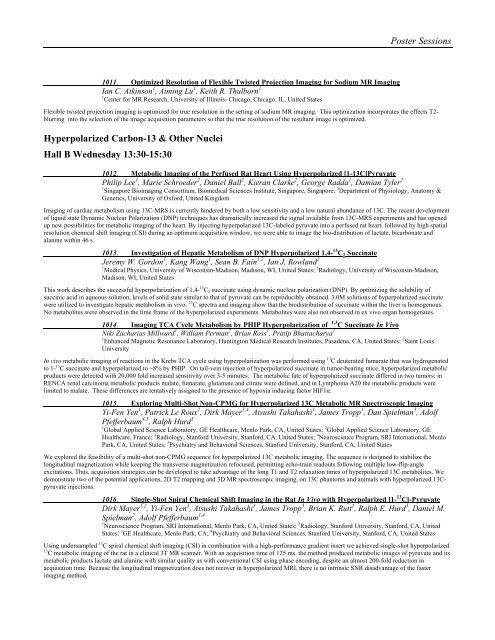TRADITIONAL POSTER - ismrm
TRADITIONAL POSTER - ismrm
TRADITIONAL POSTER - ismrm
Create successful ePaper yourself
Turn your PDF publications into a flip-book with our unique Google optimized e-Paper software.
Poster Sessions<br />
1011. Optimized Resolution of Flexible Twisted Projection Imaging for Sodium MR Imaging<br />
Ian C. Atkinson 1 , Aiming Lu 1 , Keith R. Thulborn 1<br />
1 Center for MR Research, University of Illinois- Chicago, Chicago, IL, United States<br />
Flexible twisted projection imaging is optimized for true resolution in the setting of sodium MR imaging. This optimization incorporates the effects T2-<br />
blurring into the selection of the image acquisition parameters so that the true resolution of the resultant image is optimized.<br />
Hyperpolarized Carbon-13 & Other Nuclei<br />
Hall B Wednesday 13:30-15:30<br />
1012. Metabolic Imaging of the Perfused Rat Heart Using Hyperpolarized [1-13C]Pyruvate<br />
Philip Lee 1 , Marie Schroeder 2 , Daniel Ball 2 , Kieran Clarke 2 , George Radda 1 , Damian Tyler 2<br />
1 Singapore Bioimaging Consortium, Biomedical Sciences Institute, Singapore, Singapore; 2 Department of Physiology, Anatomy &<br />
Genetics, University of Oxford, United Kingdom<br />
Imaging of cardiac metabolism using 13C-MRS is currently hindered by both a low sensitivity and a low natural abundance of 13C. The recent development<br />
of liquid state Dynamic Nuclear Polarization (DNP) techniques has dramatically increased the signal available from 13C-MRS experiments and has opened<br />
up new possibilities for metabolic imaging of the heart. By injecting hyperpolarized 13C-labeled pyruvate into a perfused rat heart, followed by high spatial<br />
resolution chemical shift imaging (CSI) during an optimum acquisition window, we were able to image the bio-distribution of lactate, bicarbonate and<br />
alanine within 46 s.<br />
1013. Investigation of Hepatic Metabolism of DNP Hyperpolarized 1,4- 13 C 2 Succinate<br />
Jeremy W. Gordon 1 , Kang Wang 1 , Sean B. Fain 1,2 , Ian J. Rowland 2<br />
1 Medical Physics, University of Wisconsin-Madison, Madison, WI, United States; 2 Radiology, University of Wisconsin-Madison,<br />
Madison, WI, United States<br />
This work describes the successful hyperpolarization of 1,4- 13 C 2 succinate using dynamic nuclear polarization (DNP). By optimizing the solubility of<br />
succinic acid in aqueous solution, levels of solid state similar to that of pyruvate can be reproducibly obtained. 3.0M solutions of hyperpolarized succinate<br />
were utilized to investigate hepatic metabolism in vivo. 13 C spectra and imaging show that the biodistribution of succinate within the liver is homogenous.<br />
No metabolites were observed in the time frame of the hyperpolarized experiments. Metabolites were also not observed in ex vivo organ homogenates.<br />
1014. Imaging TCA Cycle Metabolism by PHIP Hyperpolarization of 1,3 C Succinate In Vivo<br />
Niki Zacharias Millward 1 , William Perman 2 , Brian Ross 1 , Pratip Bhattacharya 1<br />
1 Enhanced Magnetic Resonance Laboratory, Huntington Medical Research Institutes, Pasadena, CA, United States; 2 Saint Louis<br />
University<br />
In vivo metabolic imaging of reactions in the Krebs TCA cycle using hyperpolarization was performed using 13 C deuterated fumarate that was hydrogenated<br />
to 1- 13 C succinate and hyperpolarized to ~8% by PHIP. On tail-vein injection of hyperpolarized succinate in tumor-bearing mice, hyperpolarized metabolic<br />
products were detected with 20,000 fold increased sensitivity over 3-5 minutes. The metabolic fate of hyperpolarized succinate differed in two tumors: in<br />
RENCA renal carcinoma metabolic products malate, fumarate, glutamate and citrate were defined, and in Lymphoma A20 the metabolic products were<br />
limited to malate. These differences are tentatively assigned to the presence of hypoxia inducing factor HIF1α.<br />
1015. Exploring Multi-Shot Non-CPMG for Hyperpolarized 13C Metabolic MR Spectroscopic Imaging<br />
Yi-Fen Yen 1 , Patrick Le Roux 2 , Dirk Mayer 3,4 , Atsushi Takahashi 1 , James Tropp 1 , Dan Spielman 3 , Adolf<br />
Pfefferbaum 4,5 , Ralph Hurd 1<br />
1 Global Applied Science Laboratory, GE Healthcare, Menlo Park, CA, United States; 2 Global Applied Science Laboratory, GE<br />
Healthcare, France; 3 Radiology, Stanford University, Stanford, CA, United States; 4 Neuroscience Program, SRI International, Menlo<br />
Park, CA, United States; 5 Psychiatry and Behavioral Sciences, Stanford University, Stanford, CA, United States<br />
We explored the feasibility of a multi-shot non-CPMG sequence for hyperpolarized 13C metabolic imaging. The sequence is designed to stabilize the<br />
longitudinal magnetization while keeping the transverse magnetization refocused, permitting echo-train readouts following multiple low-flip-angle<br />
excitations. Thus, acquisition strategies can be developed to take advantage of the long T1 and T2 relaxation times of hyperpolarized 13C metabolites. We<br />
demonstrate two of the potential applications, 2D T2 mapping and 3D MR spectroscopic imaging, on 13C phantoms and animals with hyperpolarized 13Cpyruvate<br />
injections.<br />
1016. Single-Shot Spiral Chemical Shift Imaging in the Rat In Vivo with Hyperpolarized [1- 13 C]-Pyruvate<br />
Dirk Mayer 1,2 , Yi-Fen Yen 3 , Atsushi Takahashi 3 , James Tropp 3 , Brian K. Rutt 2 , Ralph E. Hurd 3 , Daniel M.<br />
Spielman 2 , Adolf Pfefferbaum 1,4<br />
1 Neuroscience Program, SRI International, Menlo Park, CA, United States; 2 Radiology, Stanford University, Stanford, CA, United<br />
States; 3 GE Healthcare, Menlo Park, CA; 4 Psychiatry and Behavioral Sciences, Stanford University, Stanford, CA, United States<br />
Using undersampled 13 C spiral chemical shift imaging (CSI) in combination with a high-performance gradient insert we achieved single-shot hyperpolarized<br />
13 C metabolic imaging of the rat in a clinical 3T MR scanner. With an acquisition time of 125 ms, the method produced metabolic images of pyruvate and its<br />
metabolic products lactate and alanine with similar quality as with conventional CSI using phase encoding, despite an almost 200-fold reduction in<br />
acquisition time. Because the longitudinal magnetization does not recover in hyperpolarized MRI, there is no intrinsic SNR disadvantage of the faster<br />
imaging method.















